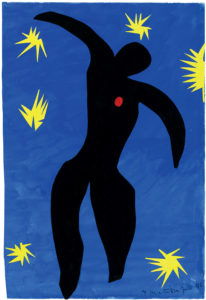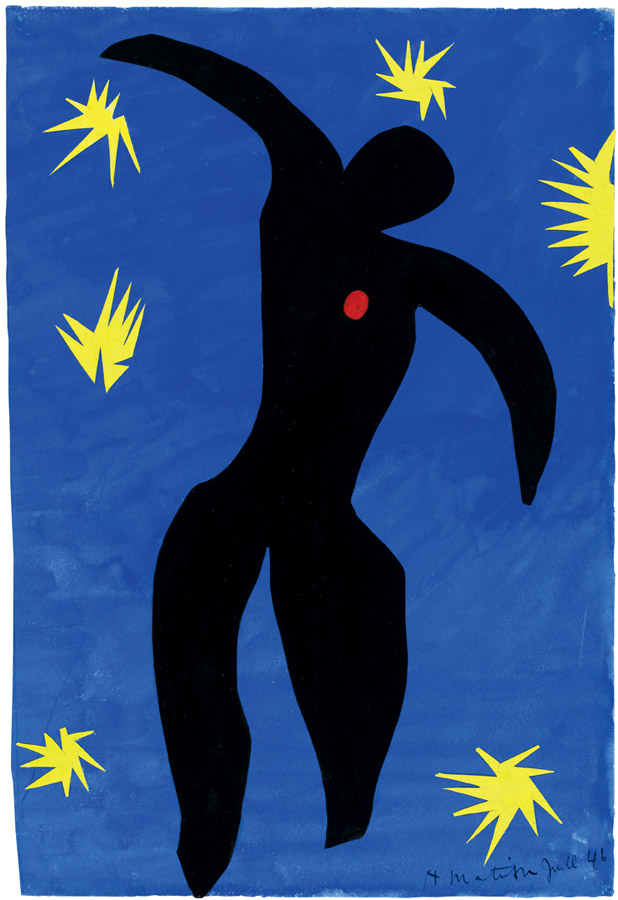By Marcia Rackow

Reprinted from the Journal of the Print World.
I think Aesthetic Realism is great because Eli Siegel, its founder, achieved a tremendous thing—he defined beauty! In his 15 Questions Is Beauty the Making One of Opposites? he provides the criterion for judging the beauty, the nature and effect of the visual arts. One of the most mysterious and difficult visual phenomenon to describe is the relation of Outline and Color, and I think his question about these opposites, in its simplicity and exactitude, would satisfy and thrill the greatest colorists, such as Titian, Delacroix, Matisse; and the greatest draughtsmen—Leonardo da Vinci, Durer, Ingres. Mr. Siegel asks:
“Does every successful example of visual art have a oneness of outward line and interior mass and color?— does the harmony of line and color in a painting show a oneness of arrest and overflow, containing and contained, without and within?”
To illustrate this I’m going to look at a work by an artist I love, Henri Matisse (1869-1954). He once said, “My problem [is] to find the accord between my drawing, the colors, and my feeling.” When, in his seventies, Matisse was no longer able to paint because of illness, he took up his scissors and began to do large paper cut-outs. “Dessiner aver des ciseaux”—To draw with scissors,” he declared at the beginning of his 1947 work, Jazz, a book of colored cut-outs on the theme of the circus. “To cut live into color,” Matisse wrote, “reminds me of the direct cutting in sculpture. This book is conceived in that spirit.” Outline and color are one in Matisse’s mind, in his conception of his work, and in the technique of the colored cut-out. That is why this work is beautiful.

Looking more closely at the plate, Icarus, one of the simplest and most moving in this book, we can see the subtlety of Matisse’s art, his love for color, and its meaning to him. This work, Jazz, he said, “was the closest thing to an autobiography.”
Icarus is the ill-fated figure of Greek mythology, whose wax wings melted when he flew too near the sun. He is depicted by Matisse in black, as he falls through that luminous blue space, lit with explosive yellow sun-bursts. The small red circular form—his beating heart—seems to cry out in that blackness, making the falling figure all the more poignant.
“Does every successful example of visual art have a oneness of outward line and interior mass and color,” Mr. Siegel asks. Yes—in the outline of his body, the wide, rising curves of his outstretched arms, his tilted head, the graceful curves of his torso, and the awkward weight of his legs, we feel the rising, floating quality of his flight, and the weight of his fall. The energy and sharpness of the outline are at one with the mass and weight of his black form and the blue space surrounding it.
1. Arrest and Overflow
And Mr. Siegel asks: “Does the harmony of line and color in a painting show a oneness of arrest and overflow?”
The shape of the heart—a small oval— bursts with redness. “One of the ways color appears in outline,” Mr. Siegel said of Matisse, is: “I’m bursting with enthusiasm!—The colors are knocking at the edges, they are not just taking it lying down. In Matisse the color almost shows a rejection of the outline, the color is so strong.” Icarus’ body is black, a subdued color. It is arrested within the contour of the figure, yet doesn’t it also seem to flow into the surrounding blue space? He is himself and of space. Icarus represents, I believe, the sense of self as individual, and self as utterly yielding to reality.
The yellow sunbursts arrest his motion, his fall. There is jubilation in their bright color and sharp, explosive shapes. Is the fall—yielding to space—a victory or a defeat? To the ego, yielding has often been associated with defeat. But I think Matisse is saying it is a victory for the self. And these yellow shapes around the circumference of the page, sustaining the figure, form a large oval shape like the small, intense red shape of his heart. Do we feel arrest and overflow as we see center and circumference made one in these forms? Does this answer a hope of ours—to be point and expansion at once—to feel that our beating hearts meet the wide, expanding universe?
2. Containing and Contained
“Does the harmony of line and color in a painting show a oneness of arrest and overflow, containing and contained?”
Mr. Siegel once asked me in relation to Matisse’s color, “Do you believe your self is contained or containing?” “I think it is both,” I said. And he explained, “When we think of space, although we are part of space, we contain space.” Here, the blue sky and yellow sun-bursts contain Icarus, and yet, aren’t they also contained by him? Icarus’ graceful, out-stretched arms seem to embrace the blue, the shapes of his body give form to the sky, contain it. His legs seem to hold the yellow forms at the bottom. And that small red heart, so tiny and contained in all this space and color seems to hold the whole composition together.
3. Without and Within
“Does the harmony of line and color in a painting show a oneness of arrest and overflow, containing and contained, without and within?”
 The red heart, the brightest point in the picture, comes forth from within the deepest part of the picture, the breast of Icarus. It is so luminous it seems that a hole had been bored into space through the black and blue—coming to pure, intense light. That light within his heart seems to come from within the center of the universe. Could this be why Matisse, as artist, felt this was “the closest thing to an autobiography?” He said, “It is through the human figure that I best succeed in expressing the nearly religious feeling that I have towards life—that deep gravity which persists in every human being.”
The red heart, the brightest point in the picture, comes forth from within the deepest part of the picture, the breast of Icarus. It is so luminous it seems that a hole had been bored into space through the black and blue—coming to pure, intense light. That light within his heart seems to come from within the center of the universe. Could this be why Matisse, as artist, felt this was “the closest thing to an autobiography?” He said, “It is through the human figure that I best succeed in expressing the nearly religious feeling that I have towards life—that deep gravity which persists in every human being.”
Matisse shows with utter simplicity, yet with such exactitude, subtlety and feeling how color—the surface of things—is deep, alive, and has great meaning and wonder. And I am grateful to have learned from Aesthetic Realism why the art of Henri Matisse is beautiful, why it is loved. It is a joyous drama of outline and color! “All beauty,” Eli Siegel stated in this historic principle, “is a making one of opposites, and the making one of opposites is what we are going after in ourselves.”
Marcia Rackow is an artist and consultant on the faculty of the Aesthetic Realism Foundation, where she teaches the museum/ gallery course The Visual Arts and the Opposites.